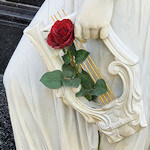
Austria and Vienna are not short of a few famous local (and adopted) sons and daughters, and a good selection of them found their last resting place in the Zentralfriedhof: Vienna’s main cemetery.
- Home to Beethoven, Brahms, Schubert, Strauss, Schoenberg, Salieri, and others
- Beautifully-kept graves and memorials in an expansive park-like cemetery
- Book a themed walking tour* of Vienna
- See also:
The graves
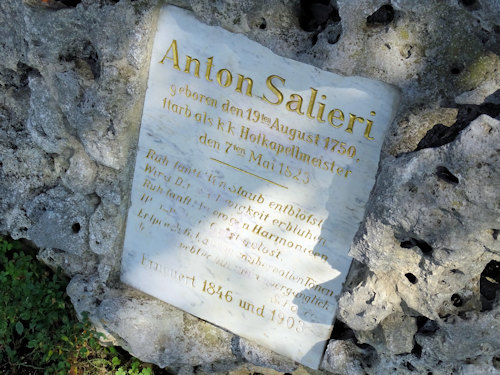
(The last resting place of Mozart’s contemporary)
Inside the Zentralfriedhof, no neon signs point to the most interesting graves and crypts. After all, this is a working cemetery even if also a notable visitor attraction with its own shop and a branch of the lovely Oberlaa Café-Konditorei chain.
The cemetery publishes its own guides, but I’ve pulled together some of the more recognisable names for you with directions added at the end. So if you wish to pay your respects to Beethoven, for example, read on.
Most (but not all) of the famous graves reside in special clusters of so-called Ehrengräber (honorary graves). The award of an Ehrengrab in the Zentralfriedhof is a particular honour bestowed by the city, and the cemetery has dozens.
What famous people are buried here?
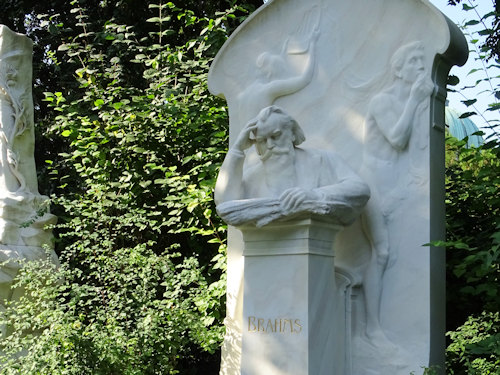
(The grave of Johannes Brahms with a gravestone designed by Ilsa Conrat)
All the post-WWII Austrian presidents have their last resting place in the Zentralfriedhof. As do numerous composers, artists, industrialists, and others who made significant contributions to Austria and/or Vienna.
Many names might not mean much outside the country or city. But plenty have indeed left an indelible impression on world history. For example…
Composers and musicians
Some of the greatest names in classical music form a self-contained collection of well-kept graves, with most located in Group 32A.
One or two passed away well before the city opened the Zentralfriedhof in 1874; the authorities moved the bodies there to create the Ehrengräber.
They hoped the “star attractions” might encourage people to visit and use the cemetery, which struggled for acceptance early on given its distance from the city center.
Ludwig Van Beethoven
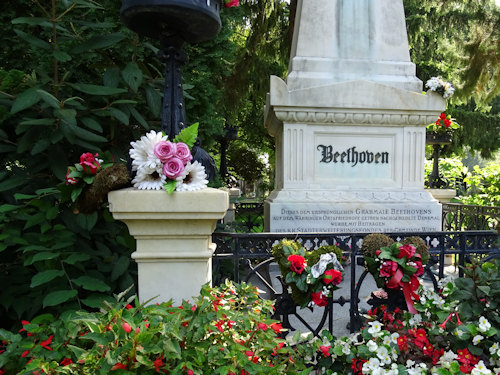
(The gravestone is actually a copy of the original)
The great composer and perhaps the most famous of all the cemetery residents died in 1827. His burial in the Zentralfriedhof was actually his third. For an explanation, see this dedicated article on Beethoven’s last resting place. (Group 32A, Grave 29)
Johannes Brahms
Another composer born abroad who found fame in Vienna. Brahms died in 1897, and his grave adjoins that of Johann Strauss the son. (Group 32A, Grave 26)
The Strauss family and Lanner
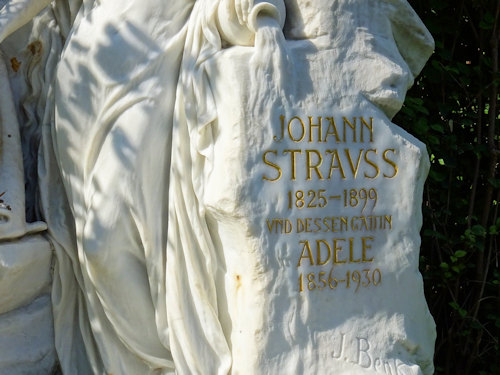
(One of several members of the Strauss family in the Zentralfriedhof)
The most influential of the Strauss family died in 1899: Johann Strauss the son is buried along with his last wife, Adele. (Group 32A, Grave 27)
The same group of graves has other members of the musical family, including Strauss’s brothers, Eduard (Grave 42) and Josef (Grave 44).
You also find Strauss’s father buried here (Grave 15), next to his friend and musical rival, Joseph Lanner (Grave 16), but he suffers the slight ignominy of the inscription Johann Strauss Vater (father), while his son’s grave is simply marked as Johann Strauss.
Wolfgang Amadeus Mozart
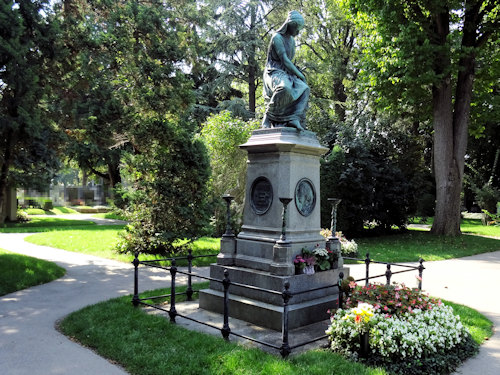
(Not actually Mozart’s grave, even if it looks like it)
I include Mozart for completeness, but the memorial close to Beethoven in the Zentralfriedhof is exactly that: just a memorial. The real grave is in St. Marx cemetery. (Group 32A Grave 55)
Antonio Salieri
Mozart’s rival in the film Amadeus (though the movie’s not historically accurate) died in 1825 and resides in Group 0 at grave 54. This is some way from most of the prominent composer graves: walk along the outer cemetery wall going north from the Tor 3 entrance to find him.
Franz Schubert
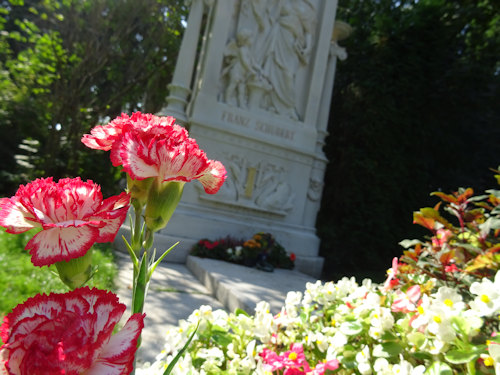
(Beethoven’s permanent neighbour)
One of the truly Viennese composers, given his birth, life and death (in 1828) in the city. Schubert’s grave lies next to Beethoven’s. (Group 32A Grave 28)
Christoph Willibald Gluck

(Another famous resident of group 32A)
The highly influential and pioneering composer of numerous operas died in 1787 and rests behind Beethoven and Schubert. (Group 32A Grave 49)
Arnold Schönberg

(The grave also lies close to Austria’s presidents)
The modern composer died in 1951 and is found not far from his older colleagues. (Group 32C Grave 21a)
Alexander von Zemlinsky
Just around the corner from Schoenberg is Alexander von Zemlinsky, who passed away in the USA in 1942. (Group 33G Grave 71)
Falco (Hans Hölzel)
The pop star of Rock me, Amadeus fame died in a road accident in 1998. Find him at grave 64 in Group 40.
Artists and writers
Johann Nestroy
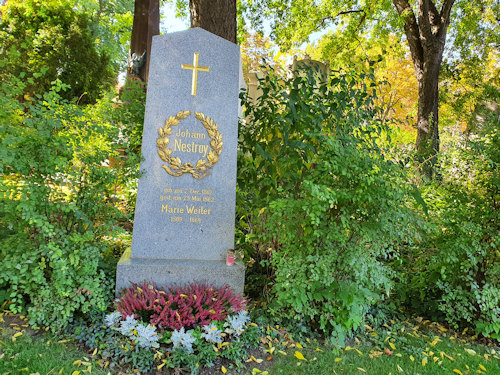
(A literary member of the cluster of famous graves)
The Austrian playwright died in 1862. (Group 32A Grave 6)
Hans Makart
Superstar artist of the late 19th century and a major influence on Klimt and others. (Group 14A Grave 32)
Caspar von Zumbusch
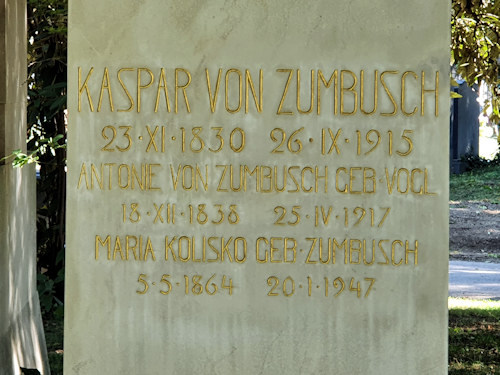
(Von Zumbusch produced well-known equestrian statues of Field Marshall Radetzky on Stubenring and Archduke Albrecht in front of the Albertina museum)
The sculptor responsible for Vienna’s main monuments to Beethoven, Empress Maria Theresa and other luminaries lies in Group 32A Grave 39.
Maria Lassnig
One of Austria’s most influential and international modern painters, who sadly passed away in 2014. (Group 33G Grave 81)
Friedrich von Amerling
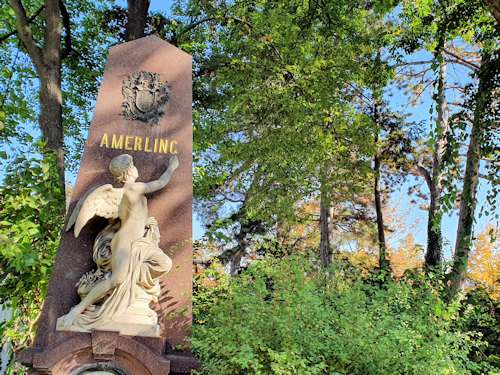
(The artist gets his own piece of shaded glade)
Biedermeier painter known for his extraordinary portraits, which put his contemporaries in the shade. (Group 14A Grave 30)
Jakob and Franz Alt

(The grave lies a little away from most of the famous ones)
Father and son landscape painters. Buried in a family grave. (Group 18 Row 2 Grave 66)
Rudolf von Alt
Jakob’s son and Franz’s brother. Also a renowned painter, particularly of city scenes using watercolours. His talents and reputation surpassed those of his relatives. (Group 14A Grave 52)
Designers and architects

(Negrelli’s grave)
- Josef Hoffmann: a giant of Vienna Modernism. (Group 14C Grave 20)
- Alois Negrelli: one of the main driving forces behind the building of the Suez Canal. (Group 32A Grave 23)
- Adolf Loos: the very end of the 0 line of graves with Salieri brings you to the architect and another key player in the Vienna Modernism movement, who died in 1933.

(Hansen’s grave)
- Michael Thonet: industrialist, developer of the bentwood production process, and designer of the famous No.14 chair. (Group 14B Grave 1)
- Theophil Hansen: architect of the Ringstrassen era and responsible for the Musikverein, Austria’s parliament building, the former stock exchange and the Academy of Fine Arts Vienna. (Group 14A Grave 20)
- Carl von Hasenauer: another architect behind many of Vienna’s most prestigious buildings around the Ringstrassen. (Group 32A Grave 33)
- Otto Prutscher: another renowned designer and architect from the era of Vienna Modernism. (Group 12C Row 16 Grave 1)
Other notable graves
Hedy Lamarr
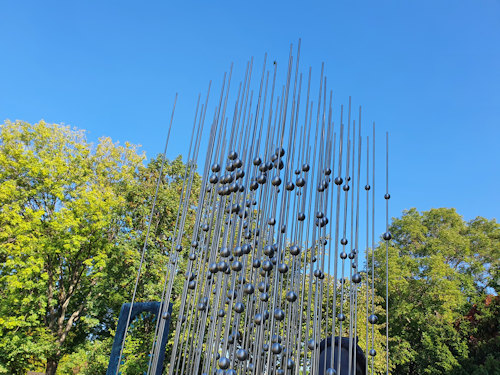
(Part gravestone, part recognition of Lamarr’s scientific achievements)
Vienna-born Lamarr became a Hollywood star and inventor. Her memorial recognises her contributions to technology with its unique form. (Group 33G Grave 80)
Matthias Sindelar
Perhaps Austria’s greatest footballer and the leading player in the Wunderteam of the early 1930s. A stone football marks his headstone. (Group 12B Row 3 Grave 11)
Ludwig Boltzmann

(Spot the equation up top)
One of the fathers of modern physics. Vienna-born Boltzmann’s famous equation on entropy is engraved on his memorial stone. (Group 14C Grave 1)
Carl Schweighofer
Business in the piano-making world. Notable because his grave appeared on the cover of Ultravox’s Vienna single and featured in the official video. (Group 32B, possibly Grave 6?)
How to find the honorary graves
First off, familiarize yourself with the cemetery’s broad layout using the “Übersichtsplan downloadable here.
You should enter through the main entrance (called “Tor 2” – bottom center of the map). Tor 2 is a stop on tram 71 that leaves from the city centre.
There are four main sections dedicated to Ehrengräber, labelled group 32A, group 32C, group 33G and group 40.
To find them, go through Tor 2 and carry on straight ahead on the avenue towards the large Jugendstil church you can see in the distance and between the large stone arcades:
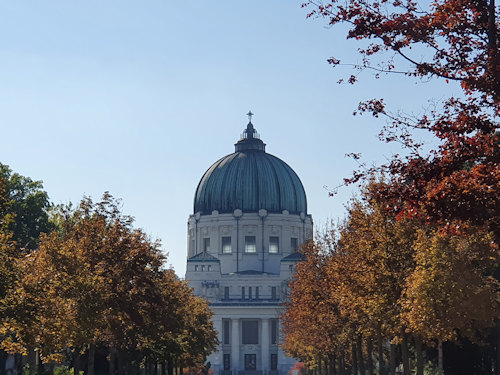
(The St. Charles Borromeo Cemetery Church)
The second section on the left after the arcades is Group 32A. The Präsidentengruft is directly ahead of you, just before the church. To its left are groups 32C and 33G. To find group 40, go west from the Präsidentengruft and keep on going until you find it.
All the groups are labeled with small signs and the more “important” ones have a map on display on a nearby noticeboard with their full layout and the names of each occupant.
How to get to the cemetery
For travel directions, see the main cemetery article.
Address: Zentralfriedhof, Simmeringer Hauptstraße 234, 1110 Vienna